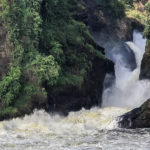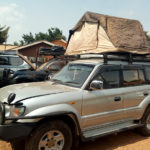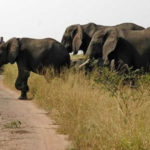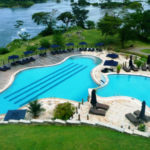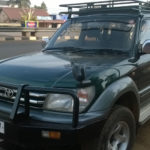The Budongo Forest in Uganda is northwest of the capital city Kampala on the way to Murchison Falls National Park, and is located on the escarpment northeast of Lake Albert. It is known for its former abundance of East African mahogany trees as well as being home to a population of chimpanzees. An exceptionally large mahogany tree is still found here, and is more than 80 meters tall and some 20 meters in circumference.
It’s composed mainly of moist, medium-altitude, semi-deciduous forest, with patches of savannah and woodland. It covers a gently rolling landscape, sloping down to the East African Rift. Four streams, Waisoke, Sonso, Kamirambwa and Siba, drain the forest and flow into Lake Albert. Annual rainfall in the area is between 1200 and 2200 mm, the rainy season being from March – May and again from September – November, the dry season being December – February.
The nearest town is Masindi, and much of the land around the forest is given over to crops, dwellings and villages, placing continuous pressure on the forest margins, and leading to exploitation for building materials and bush meat, the snares set by poachers causing mutilation of the chimpanzees and other animals. The mahogany trees that still remain are cut and removed by itinerant pit sawyers.
Recorded from Budongo are more than 360 bird species, some 290 butterflies, 130 moths, 465 trees, and 24 mammals, of which 9 are primates. Chimpanzee tracking has become an activity popular with eco – tourists, necessitating behavioural guidelines for visitors in order to avoid undue disturbance of both animals and forest. Trails have been cut criss – crossing the forest, initially to ease access for research workers and since then used by eco – tourists, forest animals and poachers.
Most visitors to the forest come for Birding or chimpanzee tracking; however, there is more to do and see here, especially if you enjoy hiking. This is the largest Mahogany Forest in East Africa, though the forest is always under threat by those looking for farm or grazing land, in recent years a real effort has been made to preserve this ecological jewel. One of the main reasons for conservation is the increasing numbers of tourist from whom the local community also benefits.
There is one Eco-Lodge inside of the forest with attractive wooden cottages set right into the forest and make it easy to go on a Chimpanzee Trek first thing in the morning. Budongo Forest also has a past, and during World War ll it was home to a large number of Polish refugees. The evidence can still be seen at the Catholic Church in the forest that is still visited by Poles and is used weekly for Church services for the local population.
Activities in Budongo Forest Reserve
Chimpanzee Habituation Experience:
Chimpanzee Habituation Experience which is an all-day activity can be done here during off-season months Low season – 1st March – 15th June and 1st October – 15th December.
The Chimpanzee Habituation Experience is done with researchers and others – a process which takes up to two years. The Jane Goodall institute manages and oversees the Chimpanzees in Budongo Forest and has done so for many years. The Chimpanzee Habituation Experience cost is considerably lower here than in it is in Kibale Forest – however there the Chimpanzee Habituation Experience (CHEX) can be done all year long. If you want to do the Chimpanzee Habituation Experience, we recommend an overnight stay at the Budongo Eco-Lodge.
Chimpanzee Tracking:
Budongo Forest is an excellent spot to track chimpanzees while visiting Murchison Falls Park. The success rate in seeing Chimpanzees is quite high here and only outdone by Kibale Forest.
There are morning and afternoon chimpanzee tracking times and for those visiting Murchison Falls National Park this can be done on the way to or from Murchison Falls National Park adding another activity to your safari there.
The ideal plan would be to stay overnight and also does a forest walk while at Budongo Forest. Do not forget that you can add on Ziwa Rhino Sanctuary where you track Rhinos on foot on your return trip to Kampala.
Guided Nature Walks Kaniyo Pabidi:
Guided nature walks can be taken here through woodland and savannah terrain.
Unbeknown to most visitors wildlife can be seen here on Nature walks and Hikes since Budongo Forest is part of the Murchison Falls Wildlife Reserve and animals enter the park, some to live here, others visit and return to their regular habitat. You can spot wildlife licking salt in in the forest clearings. Large mammals also wander into this part of park such as Elephants, Lions, Buffaloes and Leopards. A guided nature walk does not endanger you in any way, no one has ever been hurt here and you are with armed rangers.
Guided Birding Walks Kaniyo Pabidi:
Budongo Forest is one of the top areas in Uganda for those interested in birding. Birders will find Budongo literally a paradise with its 360 plus species of birds. Bird watching walks are full or half day in length led by knowledgeable guides. Certainly one must take the time to go and see the famous for birding “Royal Mile” which is a short distance in the Busingiro area of Budongo
Spot some of the following species to name a few – remember that there are 360 plus species of birds found here – Sabine’s spine tail, Cassins spine tail (rare), Pygmy crakes, Kingfishers (Chocolate backed, blue breasted, dwarf), White spotted fluff Tail, Ituri Batis, Pulvus Illadopsis, Brown twin Spot, Cameroon Somber, Cassins hawk Eagle, Crowned Eagle, Yellow crested Woodpecker, Forest Robin, Little green Sunbird, Grey headed Sunbird.
Budongo Forest Eco-Lodge:
This is a budget, moderately priced lodge – an eco – friendly establishment with tucked away cabins in forest and dorm rooms for the budget minded traveler. Food is good here along; occasionally fudge brownies are available for North American travelers who enjoy them. The service is good and the main thing is the convenient location.
You are in the forest, right at the trailhead for chimpanzee tracking, Hikes in the Forest and Birding. Expert birding guides are available and we can arrange for it. Day safari, staying overnight at Budongo Eco-Lodge, just ask us.
